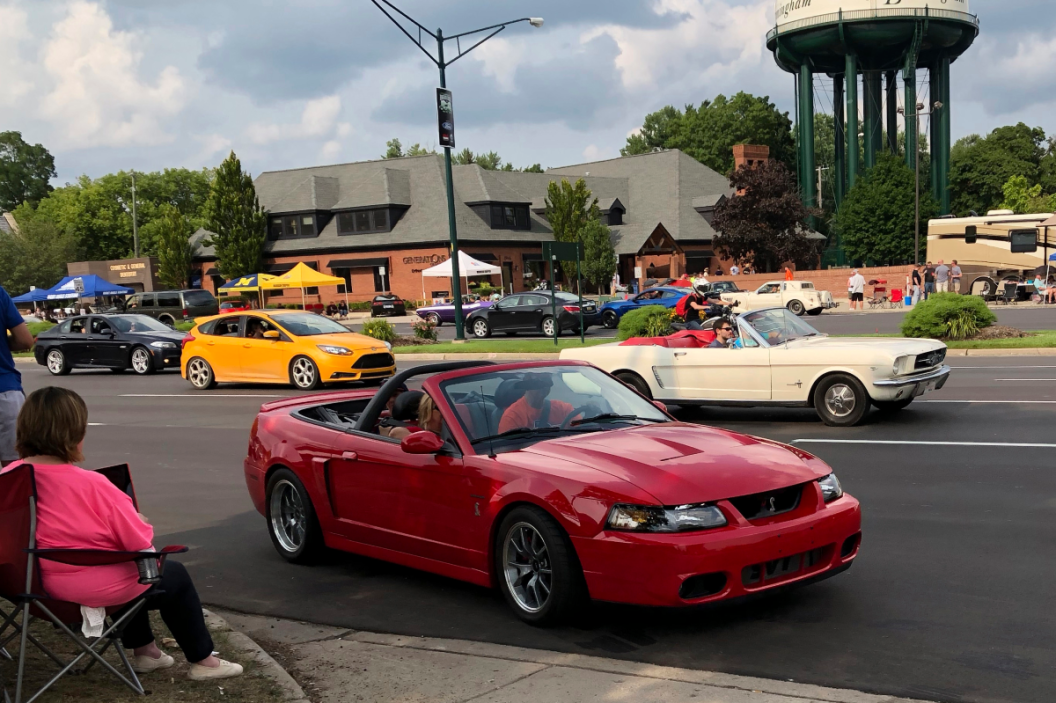Let's make one thing clear: We are neither Team Muscle Car nor Team Sports Car. Given the opportunity, we would happily test drive anything. Literally anything.
Therefore, any bias you read into this article is purely unintentional. We're not here to settle the whole debate spurred on by personal preference. Take that somewhere else, and appreciate this moment to appreciate the beauty and wonder that is American Performance Vehicles.
They're really quite stunning.
First things first: We have to know what we're talking about. You need to be able to identify these cars in the wild. When a big, sexy car rumbles by with a powerful engine, you don't want to be left looking silly saying, "I like that blue fast car." After reading this article, you too will be able to speak intelligently about all the big sexy cars on the road.
What Is a Muscle Car?
The American muscle car is a true beauty to behold. While many people consider these big and wide brutes as a product of the 1950s, '60s, and '70s, most experts consider the 1949 Oldsmobile Rocket 88 to be the very first muscle car.
In a lineup of performance cars, you can figure out which one is the true muscle car due to features like a big hood scoop and flared fenders. A full-sized sedan with a big-block engine is a muscle car.
Classic muscle cars were often a top trim or performance version of a regular sedan, such as the original GTO, which was a trim offering of the Pontiac Tempest. This translates into large trunks and a spacious, comfy interior. Commonly used for drag racing, muscle cars excel at driving very fast in a straight line.
Some of the best muscle cars of the Golden Era were the Chevrolet Chevelle SS, Oldsmobile 442, Pontiac GTO, and Plymouth Barracuda.
What happened? Where did they go? Well, the Clean Air Act and the oil embargo happened. As sexy as the muscle car may be, that V8 engine requires a significant amount of high-octane fuel. The era ended with the 1974 Pontiac Firebird Trans Am SD455.
Today, there is only one modern muscle car on the market: the Dodge Challenger. While it comes with a full array of V8 engines to choose from, the most enthralling options are the supercharged 6.2-liter Hemi Hellcat V8 with its 717 horsepower, or the mind-bending Hellcat Redeye with 797 horsepower.
Ok, So What Is A Sports Car?
Sports cars technically aren't American. The forefathers of the modern sports car were brands like Bugatti, Alfa-Romeo, and Mercedes-Benz. Even today, European brands dominate the sports car scene, with BMW, Audi, Fiat, Jaguar, and Porsche providing timeless contributions to the the high-performance world of sport cars.
Sport cars tend to have more aerodynamic body styles, with that styling creating more nimble, better handling on winding tracks.
Because they are purpose-built performance cars, most sports cars are two-door, two-seater coupes or convertibles. They may or may not have a trunk. Why do you even need a trunk? That's just more weight, and we're trying to hit top speed here. Think Mazda Miata, or the Nissan GTR.
You don't even have to be a car enthusiast to guess that America's first sports car was the Chevrolet Corvette. The Corvette was intended to be shown to the public in 1953 as a concept car, but quickly pushed into production due to public demand. Today, the Corvette continues to thrive, though some argue today's models are more supercar than sports car.
Supercar? Are You Making This More Difficult on Purpose?
Not on purpose. A supercar is an entirely different thing. By definition, a supercar is a high-performance luxury car, which means astronomical price point, tremendous amounts of horsepower, dubious street-legal status, and an insurance premium that would feed a small county. Modern Bugatti and Lamborghini are supercars, not the Mercury Cyclone.
But, while we're here, let's talk about pony cars. A pony car is an American car that's not quite a muscle car or a sports car. The term was coined by the 1964 Ford Mustang, because it's like a small horse.
Pony cars started as two-door, four-seater models that were specifically both stylish and affordable. They feature small block engines, usually V6s, though V8s are often a sought-after option.
The Ford Mustang is considered the queen of the pony cars, but some argue that the Shelby Mustang GT 500 is a muscle car, and the Mustang GT 350 is a sports car. That's fine. We'll allow it. The same can be said of the Chevrolet Camaro, with the ZL1 tearing up the track, and the COPO having its own place in history.
Now, some will argue that muscle cars and sports cars must have rear-wheel drive, but today's manufacturers are making more and more all-wheel drive models, so that's no longer a valid argument. Some also say that the Dodge Charger is both a muscle car and a pony car, but honestly, that's a different topic altogether.
Really, there's no contest. Muscle cars and sports cars are very different things, both of which are beautiful in their own unique ways. There's something about a Plymouth Barracuda growling up the road that stirs the soul, while a Porsche 911 streaking by on the freeway may inspire your creativity and passion for freedom.
Either way, the cars are just really, really cool.
Products featured on Alt_driver are independently selected by our editors. However, when you buy something through our links, we may earn a commission.
